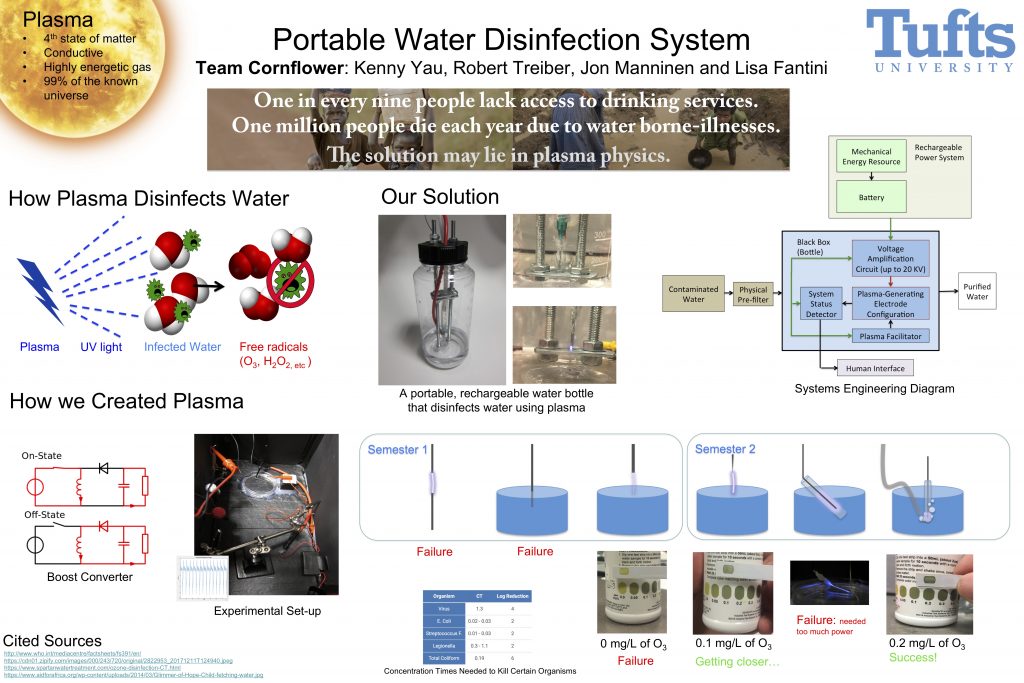Cornflower Team 2018
Personal Plasma Water Filtration
Given the lack of clean water supply in the world today, we aim to produce an affordable, portable, energy-efficient device that provides potable water to those who need it. We plan to complete a working prototype by May 2018. The need for clean water rises as the population continues to grow. Many communities lack the infrastructure necessary for providing drinkable water. Other communities, despite having these infrastructures, are sometimes unable to provide their citizens with clean water when natural disasters strike. During major floods, people are surrounded by undrinkable water contaminated with bacteria, viruses and volatile organic compounds (VOC’s). While there are many different types of water filtration systems readily available to the general public, concerns such as cost, effectiveness and portability still exist. For example: current affordable options for water filtration filter out over 99% of bacteria, but do not filter out smaller sized viruses or VOC’s such as gasoline and oil that commonly plague flood waters.
The solution to this problem could reside in plasma research. Water purification using plasma has been proven to destroy 100% of bacteria and viruses and its effectiveness is also being tested to decompose VOC’s. Low power consumption systems have been built in Argentina and the United Kingdom to provide large volumes of drinkable water on the community scale. However, in disaster scenarios, power is often down for a matter of weeks, and often, citizens are evacuated and some are left on their own without infrastructure. When no infrastructure exists to provide a population with clean water, the members of these communities must themselves find clean water. The goal of this project is to create a portable water bottle attachment that uses plasma to filter the water. The volume we aim to try and purify ranges from 12-64 ounces.
The filter will allow people to attach it to a standard wide-mouth water bottle and pump water from virtually any source. A pre-filter will be used to filter out larger sediment before entering the purification chamber containing the plasma purification process. Incorporated into the design will be a status bar, monitoring power levels and pressures inside the chamber. A USB cable attached to an outlet or a hand crank will recharge the batteries powering the unit.
The plasma disinfects water by emitting UV light. UV light is energetic enough to break water into free radicals. These free radicals destroy any impurities in the water.
While this plasma-purification process has been tested and proven effective, it remains to be seen on a smaller, individual scale. We are still unsure whether or not a portable battery can provide power for such a process. Other issues are centered on the nature of plasma itself. Ozone created in the filtered water could react with bromide to produce bromate, a carcinogenic substance. The removal of this carcinogen is extremely difficult, and lies outside of the scope of our project. Therefore, our product must only be used with sources of water that do not contain these chemical specimens. Since, however, this is difficult to ascertain, our product will mostly act as a proof of concept. Until chemical engineering detection and removal methods improve, our product cannot be used on any water source.
Related Tech Notes
- Bromate Detection Via Ion Chromatography and Inductively Coupled Plasma-Mass Spectroscopy by Lisa Fantini
- DC Boost Conversion to Obtain High Voltages for Plasma Generation by Jon Manninen
- Converting Renewable Energy into Electricity: Alternating Current (AC) Generators by Robert Treiber
- Plasma Physics by Kenny Yau

